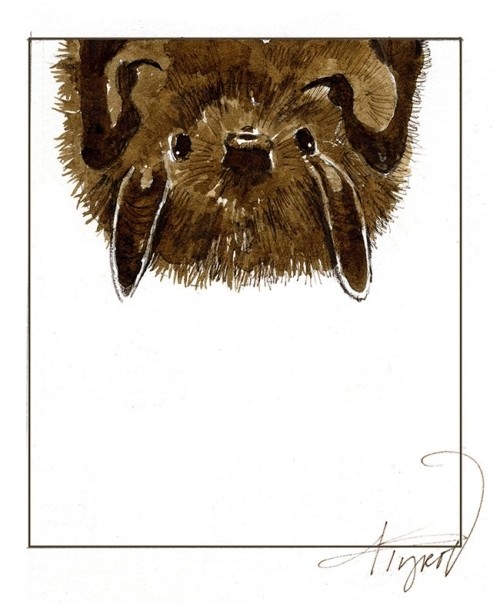
In 2006, I joined a team of biologists to trap bats in Vermont’s Chittenden County. We were searching for North America’s rarest bat, the Indiana bat, which had recently been discovered breeding in a forest in Middlebury. The biologists hoped to identify additional populations of this endangered species and develop a better sense of how they were faring. So we set up a series of mist nets – fine nets on poles up to 30 feet tall placed along forest trails and at the edge of fields – and we watched the nets for two consecutive nights. We trapped dozens of bats of five species, but found no Indianas.
I wrote about my bat trapping experience in my 2007 book Golden Wings and Hairy Toes. The hairy toes part of the title references the best way to differentiate an Indiana bat from the then-abundant little brown bat – by the length of the hair on its toes. But by the time the book was published, delineating the breeding range of the Indiana bat in Vermont was no longer the priority it once was. That’s because hibernating bats in the Northeast were being found dead and dying by the thousands and no one knew why.
The mystery disease was first discovered in a cave in New York in the winter of 2006-07. Masses of dead bats were soon found in hibernacula in Vermont and New Hampshire as well, and within seven years the disease spread to 26 states and five Canadian provinces. About a half million bats are believed to have died in Vermont alone from what became known as white nose syndrome, and nearly six million have perished nationwide.
Named for the white fungus that appears on a bat’s nose, ears, and wings during hibernation, the disease causes bats to awaken in the middle of winter, forcing them to increase their metabolic rate and expend energy at a time when no flying insects are available to eat. Almost all infected bats perish, and in many hibernacula more than 90 percent of the animals become infected.
According to Alyssa Bennett, biologist for the Vermont Department of Fish and Wildlife, no one knows how many bats wintered in the 30 known hibernacula in the state before the disease spread throughout the region. Nor is it known how many other caves, mines or other underground sites may host hibernating bats in Vermont. But all six species of bats that spend the winter in northern New England have been affected. Little brown bats, the most abundant species in the region prior to the outbreak and the species most likely to be found breeding in attics and barns during the summer, have declined by about 90 percent in the Northeast. Tri-colored bats and Indiana bats have also suffered significant declines, though they were never very common in New Hampshire or Vermont to begin with.
The hardest hit of the region’s bats is the northern long-eared bat, which has declined by about 98 percent since the disease outbreak. Bennett is worried that it may be the one species that never recovers. While the rate of decline has slowed for all other species, long-eared bats are still dying at a high rate. At Vermont’s largest hibernacula, Aeolus Cave, northern long-eared bats represent less than one percent of the cave’s current bat population of about 30,000 animals (down from about 350,000 in the 1960s), but they represent about half of all the bats found dead there since 2012.
Big brown bats and eastern small-footed bats have also been affected by the disease, though their declines have been much less dramatic, perhaps because they hibernate in cooler, drier sites that are not conducive to the moisture-loving fungus. Big browns, which commonly breed in attics and barns, are likely to recover most quickly, because they produce more young than the other species, and the decline of the little brown bat will mean more places for big browns to reproduce. The region’s other three bat species – the hoary, silver-haired and eastern red – faced no ill-effects from the disease because they migrate south for the winter and do not hibernate.
To fight the continuing effects of the disease, scientists are studying possible treatments for white nose syndrome. One effort involves the creation of a bacterial spray developed from a bacterium found naturally on the skin of big brown bats that may suppress the fungus and help them survive the winter.
Sadly, the disease has already left a lasting mark in the Northeast. Little brown, northern long-eared, and tri-colored bats have been added to the Vermont and New Hampshire endangered species lists, and state biologists are doing what they can to protect habitat and study the animals. Now it’s up to the remaining bats to undertake the long process of rebuilding their populations. With most species producing just one pup each year, it may take a century or more to reach pre-disease levels.


Discussion *